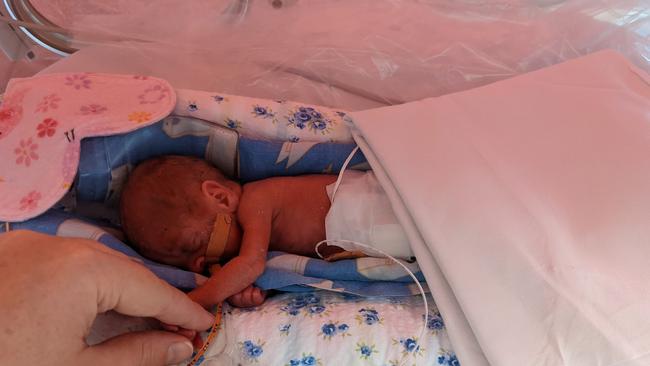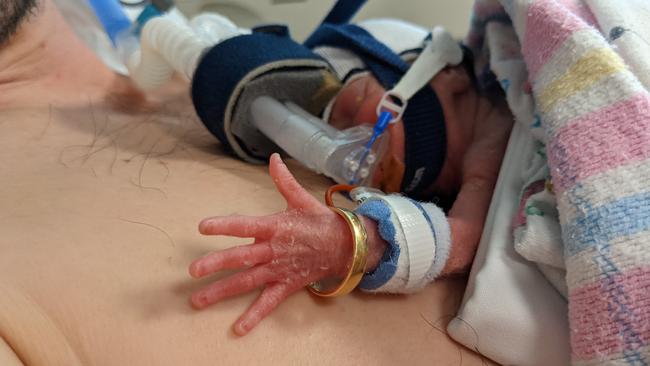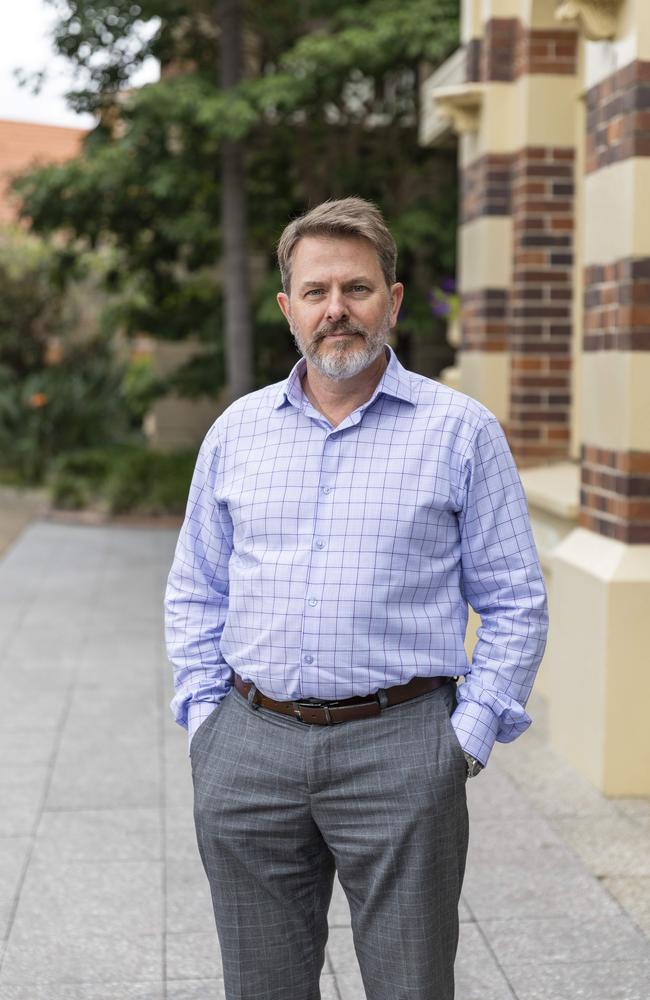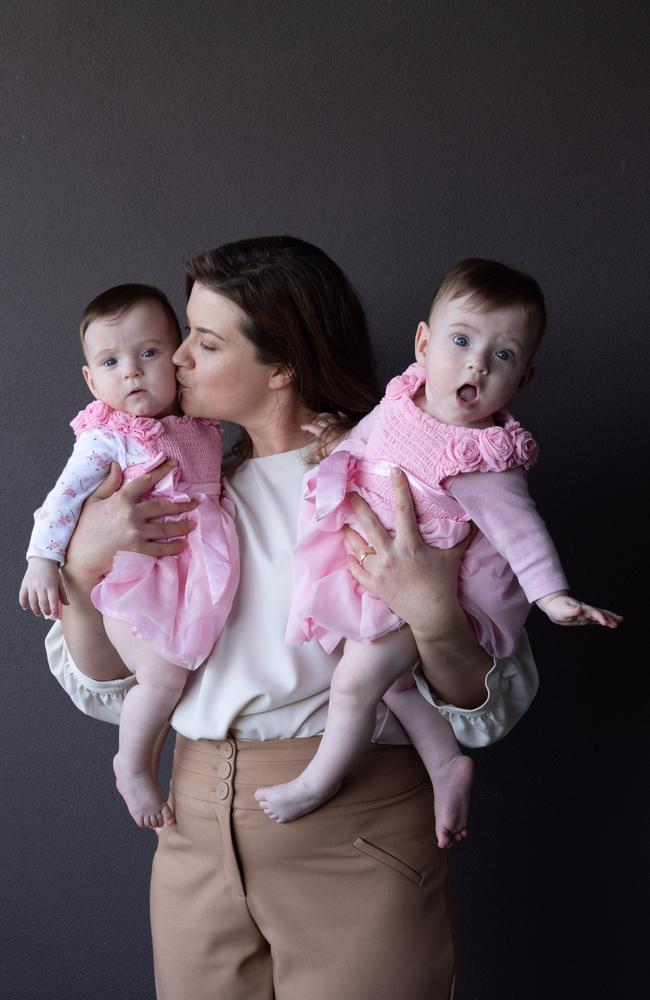Babies’ life-and-death 72-hour wait after incredible in-utero surgery
Sierra Olave knew the life-saving surgery her unborn twins needed would likely bring on early labour. But then it started at just 22 weeks, five days - almost 18 weeks too early. This is her girls’ miraculous story.
QWeekend
Don't miss out on the headlines from QWeekend. Followed categories will be added to My News.
Young Evelyn Olave has found her voice. It is loud and demanding and the most beautiful music to her mother’s ears.
Evelyn, or Evie, born with her identical twin sister Genevieve at a breathtakingly early gestation of 23 weeks and one day, came within a whisker of known survival rates for premature babies.
Born on November 10, 2020, but not due until March 8 this year, the twins, sharing a single placenta, suffered a rare condition called Twin to Twin Transfusion Syndrome (TTTS).
Sierra Olave, who works for Mater Education training doctors and nurses to use IT systems, underwent fetal laser surgery at the Mater Hospital’s Centre for Maternal Fetal Medicine when she was 19 weeks pregnant.
The procedure usually brings on early labour but doctors were hopeful she would make it to at least 25 weeks gestation, giving the babies a better chance of survival.
But Olave went into labour at just 22 weeks and five days – almost 18 weeks too early.
She was hospitalised at the Mater Mothers’ Hospital where doctors did everything they could to delay her giving birth. Evie and Genevieve were born just days later, at 23 weeks and one day gestation.
After spending months in Mater’s Neonatal Critical Care Unit (NCCU) and overcoming a multitude of serious health concerns, the twins are now both home and thriving.

Olave, of Stones Corner, in Brisbane’s inner south, says those “magic 72 hours’’ between going into labour and giving birth were the difference between her twins probably not surviving and having a fighting chance.
“The conversations (my husband) Tim and I and the doctors were having at 22 weeks and five days were along the lines of, ‘We will provide comfort care because they are too early’.
“But at 23 weeks and one day, it was, ‘We will try’. Every hour of gestation makes a difference at that stage.
“It was just over the line but, at 23 weeks and one day, we had hope.’’
The babies were born naturally, rather than by caesarean section, with doctors advising that if the girls didn’t survive the trauma of birth then they were unlikely to survive at all.
Evie was born first, weighing in at 526g, with Genevieve an even tinier 470g.
Both girls have faced serious complications including underdeveloped lungs and chronic neonatal lung disease, needing home oxygen, suspected dangerous intestinal disease necrotising enterocolitis and treatment for a condition affecting their eyes called retinopathy of prematurity (ROP).


Even though Evie was born the larger twin, she has had more difficulties, including a severe intraventricular haemorrhage or brain bleed at birth and spent 150 days in NCCU, compared with Genevieve’s 111 days. Evie only came off her 24-hour home oxygen support this month, making her loud yelling and workout of her lungs even more remarkable.
Both girls, but particularly Evie, are still at risk of developing cerebral palsy – a physical disability that affects muscle control.
The rollercoaster of emotions since the twins’ birth has been both joyous and devastating, with the Olaves pulled between celebrating how well one daughter was doing while being worried the other might not survive.
In the hours and weeks and months when one or both of her girls were clinging to life, Olave has entertained the different futures of her family. There has been the future of having just one baby survive. Or the dare-to-dream scenario of both their babies surviving. In those early weeks, they also stared down the barrel of despair of a future where both their girls were lost.
And so with each milestone their babies now achieve – rolling over, sitting up, laughing, even teething – they celebrate it for the miracle it is.
These twins are just two of the tiny patients to benefit from the Mater Foundation’s fundraising efforts.

Olave knew early on that her pregnancy was risky. At her first six week scan, the doctor not only told her she was having identical twins (“you could have knocked me over with a feather”) but that the babies shared the same placenta. This gave her a higher risk of TTTS, a condition that affects about one in 10 of twins sharing a single placenta.
It is caused by shared blood vessels running on the surface of the placenta with an imbalance of blood flow from one twin to the other. One twin is overloaded with blood and will produce excessive amounts of amniotic fluid, while the other twin will not get enough.
Left untreated, TTTS can cause serious health conditions and the likelihood that both twins will die.
At 16 weeks, the deadly condition was indeed affecting Olave’s babies and after weekly, then daily, ultrasound scans, maternal fetal medicine specialist Dr Glenn Gardener performed fetal laser surgery when Olave was 19 weeks pregnant.
Dr Gardener, 53, director of the Mater Centre for Maternal Fetal Medicine at Mater Mothers’ Hospitals, has performed about 200 of these surgeries since 2003.

He says in about 90 per cent of TTTS cases, babies are expected to die if left untreated, compared with an about 75 per cent survival rate of both twins with surgery.
Having the surgery, he says, is “an absolute no-brainer” despite one of its risks being preterm births.
“But you are between a rock and a hard place – if you don’t treat, they die, but if you treat and you fix the twin to twin (TTTS) you are at risk of preterm birth. When TTTS occurs early in pregnancy, that’s the dilemma,” Dr Gardener says.
“Sierra’s twins are pretty amazing in that they had twin to twin, they were delivered at 23 weeks including one baby who was under 500g, and both survived. It’s quite remarkable. Evelyn did have some significant issues but they still pulled through and have done very well.”
Dr Gardener says their birth, at 23 weeks and one day, is right at the “starting point” of survivability.
“It’s super early,” he says.
“Internationally, there are some babies that are being resuscitated at 22 weeks in Sweden and Japan. Within Australia, in general, 23 weeks is our starting point and it would never have been possible in years gone by.”
The surgery, performed under twilight sedation and local anaesthetic, involves a port, about the size of a drinking straw, put through the skin, through the uterus and into the amniotic cavity of the baby who has the excess amniotic fluid.
A small camera, called a fetoscope, is fed through the port as well as a laser fibre.
“I aim to trace the blood vessels that go from one (umbilical) cord to the other and, where I see they connect, I laser that to stop the blood flow. I’m aiming to separate their circulation,” Dr Gardener says.
“You have to be very precise and it typically takes about an hour and a half.
“We expect, on average, women to get 10 weeks after a laser before they deliver. Some will get to the end of their pregnancy, others may only get four weeks like Sierra. It’s a bit of a lottery. But given the odds, you don’t have a lot of choice.
“In Sierra’s case, the procedure was quite complicated because her placenta was in front where we wanted to operate.
“We have to find a window to be able to put the fetoscope into the uterus. You can’t push it through the placenta. You do an ultrasound and plan exactly where that port goes.
“If you get that wrong, that’s kind of it.”
Dr Gardener works with a large specialty team at the Mater Mothers Hospital. They are the only site in Australia and New Zealand performing fetal surgery for diaphragmatic hernia and spina bifida, learning the techniques that have been developed in Europe and the United States. He says doing fetal surgery where he can see the unborn baby never ceases to amaze him.
“The ability to see a baby in the womb is such a privilege. It never fails to amaze me. You do have that sense you shouldn’t be there,” he says.
“When I put a scope in and I see the fetus sitting there as happy as Larry in the amniotic fluid I think, ‘wow, that’s not something you see every day’.”

Olave kept a diary of her girls’ first 50 days.
It outlines the blur of heartbreak, devastating setbacks and close calls but also the small joys and hurdles overcome. In December 2020, just shy of one month since her daughters were born, Olave recalls one of her worst moments while holding a tiny Evie on her chest.
Olave had not long been told that Evie, who was on a high level of oxygen and possibly suffering necrotising enterocolitis, was “weak of spirit”.
She held her daughter on her chest and loved her as much as a mother could.
Olave heard Evie make a tiny gasp and watched in horror as her daughter started choking on her oxygen tube, quickly losing her colour and turning grey. In the panic of those moments and among the rush of doctors and nurses who hastily surrounded her, Olave thought that if she was to lose her girl, that this was probably not a bad way for her to go – while she was on her body, secure and loved.
“Some of the days were really hard,” Olave says.
“Evie turned grey on me and I remember thinking this is Evie deciding which way she goes. I thought, well it’s not bad, she’s on me with all this care around her. So if this is the way it goes, that’s how it goes.
“There are no words that can describe how I felt. There was fear but also something like relief that if my daughter was going to die, that at least she was on my chest.”

Olave says she also had to learn to compartmentalise her emotions – to keep joy in her heart for one twin who was doing well while battling heartbreak for the other twin who was not.
“You walk in to the NCCU and there are two nurses – one for each baby. You see Evie and she wasn’t always well. The talk was of what has happened, what her treatment is going forward and our hopes are pretty low. You’ve got bad news here.
“Then you walk across to the other baby, to Gen, who is pink cheeked and fidgeting and blooming. You’ve got to figure out how to be happy that one of your babies is doing really well and be proud of them and enjoy that emotion.
“That was really difficult. You’ve got to figure out how to be happy and proud of one baby but also be worried and devastated for the other. There was so much conflicting emotion.
“Early on, one of the nurses told me that my most important job was to make breast milk to give the girls the best chance. That gave me a focus. It was hard but every single drop I made was such an accomplishment.”
When the girls were three months old – still only 36 weeks gestational age – they graduated onto low-flow oxygen which meant Olave and Tim could finally hold their babies without nursing support and they could change their nappies and clothes more easily.
Importantly, Olave could also start breastfeeding (instead of expressing milk for the girls). For the first time, the possibility of the girls coming home started to feel “within grasp”.
When Genevieve was finally allowed to go home, it was a happy day but one that also tore at their hearts.
“When we had Gen at home and Evie was still in the hospital, it was a whole new level of hard,” Olave says.
“Tim and I knew they were both going to be OK at that stage but I knew I was missing out on a thousand beautiful moments with Evie. More tears were shed during that period than in their first week.
“I’d arrive at the hospital at 7am in the morning and leave at 7pm. Walking out of the hospital, away from your baby, was so hard.”

Olave has supported Mater Prize Home for about 10 years – as long as she has worked in her role at the Mater. Aside from occasionally pondering how sweet it would be to win a beautiful new home, she never really gave too much thought to where her supporter money was going, let alone realise the direct impact it would one day have on her family.
The Mater Foundation, the philanthropic arm of Mater, raises money from community, corporate, trusts and foundations to fund research, education and patient care across Queensland and beyond.
It has operated Mater Prize Home since 1954 to raise vital funds to support medical research and exceptional patient care.
Dr Gardener says community support of Mater Prize Home is invaluable.
“When people buy a ticket, it’s great you might win a prize but that money is actually going to help someone,” he says.
This support enables Mater Foundation to purchase specialised equipment and fund research to benefit their tiniest patients.
Olave says she will be forever grateful for the level of care her girls received.
“Every time you buy a (Mater Prize Home) ticket, it makes a huge change for babies in NCCU like mine,” she says.
“I had a lot of things to worry about, but one worry I didn’t have was availability of care. I never had to stress that the Mater wouldn’t have the equipment or that doctors wouldn’t try something because they didn’t have funding to be able to do it.
“It’s not just the chance of winning a house that people are buying into, it’s funding hospital equipment and incredible patient care and also supporting medical research. You can’t really underestimate what a difference it makes.
“For our family, going from possibly losing both our girls, to now being at home with two thriving babies, it is an absolute miracle. We are so grateful for the care they received.”

Now, as the girls approach their first birthday, and as Olave is finally enjoying her maternity leave at home, she watches her babies sit opposite each other. They are at a glorious stage of finding each other hilarious, bursting into continuing gales of laughter.
It’s a ‘pinch me’ moment that Olave still can’t quite believe she gets to experience.
“I’m quite happy if they are the most difficult toddlers in the entire world. They can wake up three times in the night, it doesn’t matter, I’m happy because they are at home,” Olave says.
“Each milestone they reach is wonderful. If they can be cheeky and noisy and shout, I’m happy because they have got the lungs to do it. It really is music to my ears.”
You can support premature babies like Evie and Genevieve get the best possible start in life through buying tickets in Mater Prize Home. You really are changing lives with every ticket that you buy. Tickets from $2 at materlotteries.com.au or call 1800 067 066.




